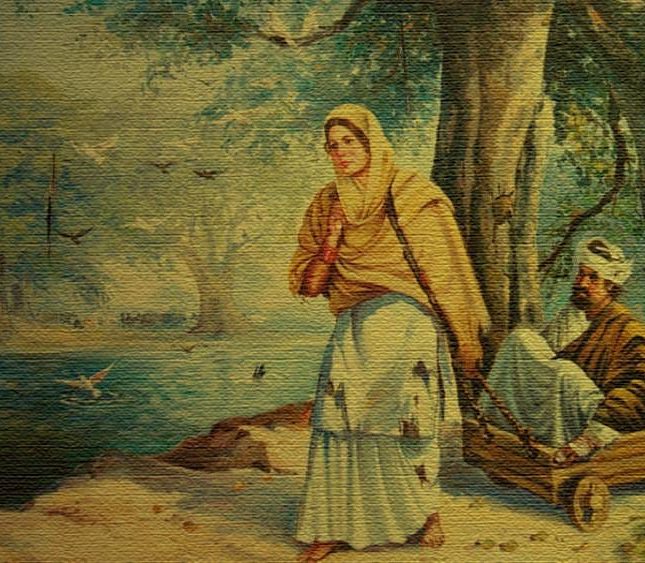RAJANI, BIBI, was, according to a tradition recorded by Giani Gian Singh, Panth Prakash, the youngest of the five daughters of Duni Chand, a 16th century Kaura Khatri and a rich landlord and revenue collector of Patti, an old town 44 km southwest of Amritsar. Once, during a conversation, while the four elder daughters expressed their indebtedness to their father alone for the comforts and luxury they enjoyed, Rajant differed from them saying that, though their father was no doubt kind to them, the source of all bounty was God, the sustainer of entire existence. Duni Chand, a vainglorious man, was annoyed at the views of the child whom he rebuked for what he considered her ungratefulness. In order to teach her a lesson, he married her to Vikram Datt, a poor leper of Patti itself.
Rajant, unshaken in her faith in God, served her husband with devotion. Carrying her helpless husband in a basket on her head, she lived on the proceeds other own labour and alms given by compassionate householders. One day she happened to visit the site where Guru Ram Das (1534-81) was in the process of founding a new habitation, Amritsar of modern day. Rajant sat her invalid husband under a ber tree (Zizyphus mauritiand) on the bank of a pond and went to bring food from the langar or free kitchen she knew the Guru maintained.
Vikram Datt, Rajam`s husband, while sitting alone under the tree had a vision. He saw, so goes the tradition, a crow having a dip in the pond and emerging from it with its colour turned pure white. Vikram Datt got an inspiration. He dragged himself to the water, bathed in it, and was instantly and completely cured of leprosy.
Rajant, on her return, could hardly believe her eyes. The couple then went and reported the mircale to Guru Ram Das, who decided to develop the pond into a properly lined tank. He called the lank Amritsar, the Pool of Nectar, which name in due course passed on to the habitation as well. The ber tree near which Bibi Rajani`s husband had washed his affliction away came to be known as Dukhbhanjani (eradicator of woes) Ben.
It can still be seen in the parikramd or circumam bulatory terrace around the pool in the middle of which stands today the famed Golden Temple. A gurudwara and a women`s college at Patti are named after Bibi Rajani.
References :
1. Santokh Singh, Bhai, Sri Gur Pratdp Suraj Granth. Amritsar, 1927-35
2. Gian Singh, Giani, Twarikh Guru Khalsd [Reprint]. Patiala, 1970
3. Amole, S.S., Amritsar. Patiala, 1975
Bibi Rajani’s story is one of profound faith, endurance, and divine intervention that has come to be intertwined with the very origins of Amritsar. In the era of Guru Ram Das, she is remembered as a devoted Sikh whose piety and trust in Waheguru (God) shone brightly even in the face of severe hardships. Born as the youngest daughter of Rai Duni Chand—a revenue collector (kardar) of Patti—she grew up with a deep awareness that every blessing, every trial, was an expression of the Divine’s will.
Her commitment to her faith was so pure that when her father, dismayed by her habit of attributing all blessings to God, imposed a harsh lesson upon her by marrying her off to a man afflicted with leprosy, she accepted her fate with a grace that belied the grimness of her circumstances. Rather than succumbing to bitterness, Bibi Rajani continued to live with unwavering devotion. She nursed her leper husband, never faltering in her daily remembrance of God despite the challenges of poverty and the stigma surrounding his illness.
The miraculous turning point in her saga occurred when, on one of her routine errands, she set her husband’s basket by the side of a pool. As destiny would have it, while Bibi Rajani was away, her ailing husband witnessed a small crow dipping into the pool’s water and emerging with a striking change—the bird’s dark hue transformed into a dazzling white. Inspired by this vision, he mustered the strength to dip himself into the pool. In that sacred moment, the waters worked their miracle: he was completely cured of his affliction. Although initially startled and unsure of his transformed appearance, a lingering mark on one finger confirmed his identity to his loving wife. Overjoyed and filled with gratitude, they sought the blessings of the Guru together. This very pool, touched by divine grace, came to be celebrated as the sacred Amrit Sarovar—the heart of what would later rise as the Harmandir Sahib in Amritsar.
The saga of Bibi Rajani is much more than a tale of personal redemption—it is a vibrant thread in the tapestry of Sikh lore, one that speaks about the power of steadfast faith amid life’s most trying circumstances. Her experience reassures devotees that even the most severe trials may pave the way to miraculous healing and spiritual rebirth. The lesson is timeless: by surrendering to the Divine Will and remaining resolute in one’s devotion, human life can be transformed, and the seeds of sacred spaces, such as Amritsar, can be sown.
Bibi Rajani’s legacy invites us to reflect on the myriad ways in which personal sacrifice and spiritual devotion can create ripples that shape history. Her story is often recalled alongside other miraculous narratives in Sikhism, underscoring the belief that acts of pure faith not only nurture the individual soul but also contribute to the collective spirit of the community. This narrative, steeped in the symbolism of transformation—from the leprous affliction to a complete healing mirrored in the sanctified waters of Amritsar—continues to inspire generations, offering hope and affirmation that in every hardship lies the potential for divine grace.



